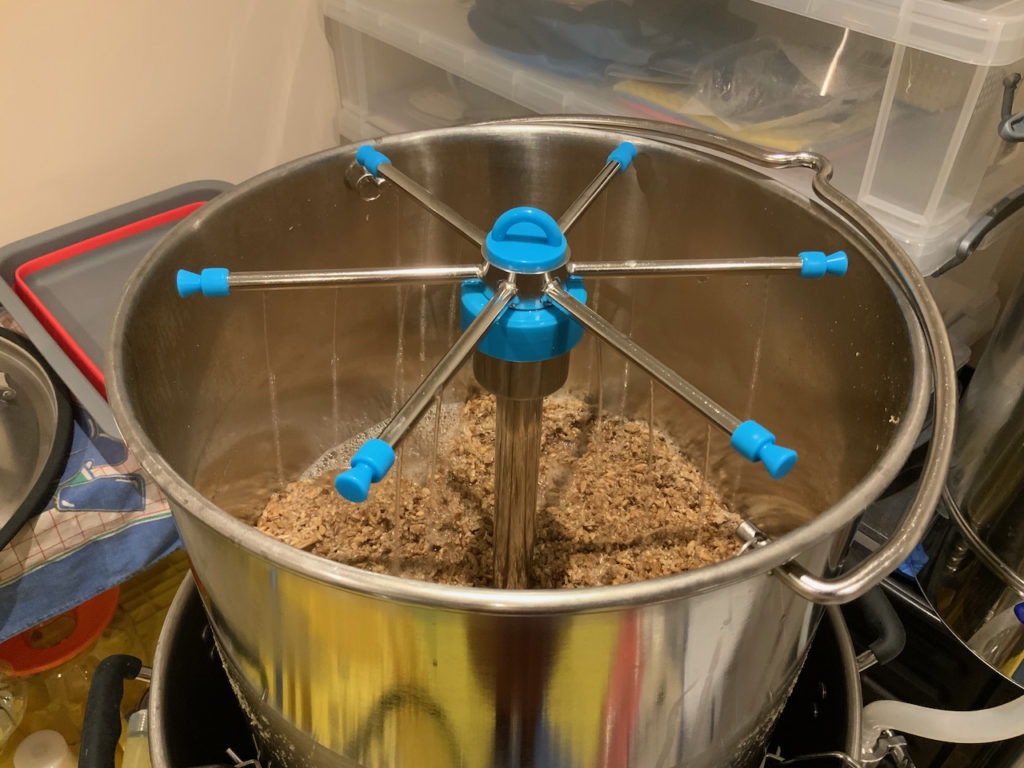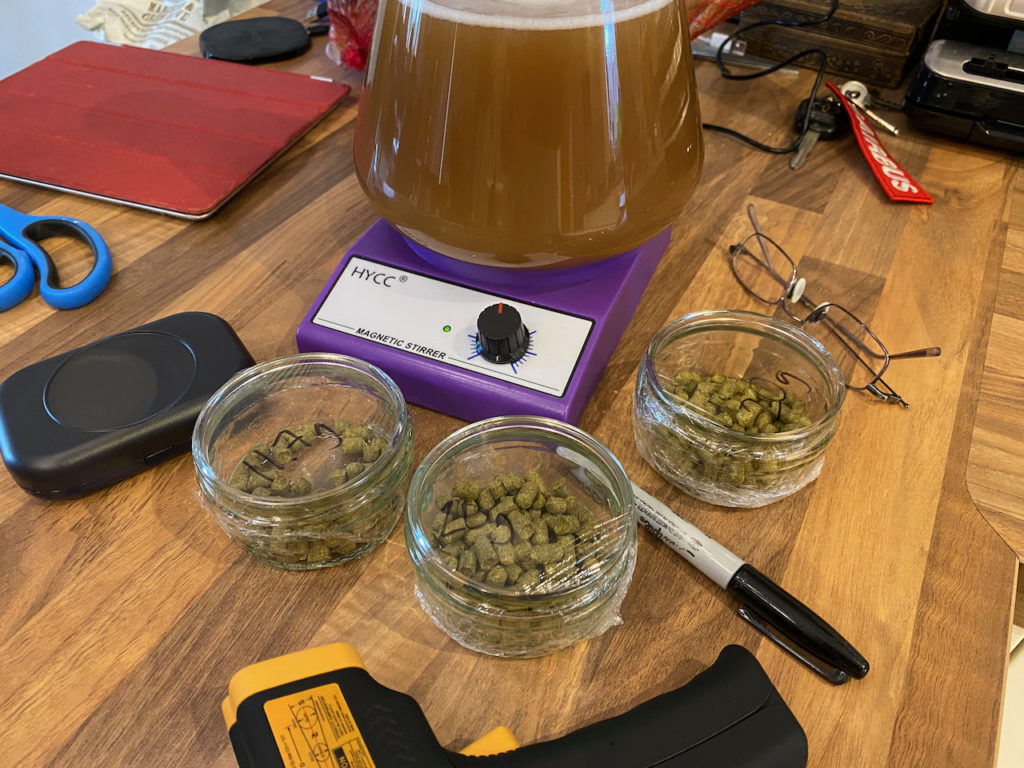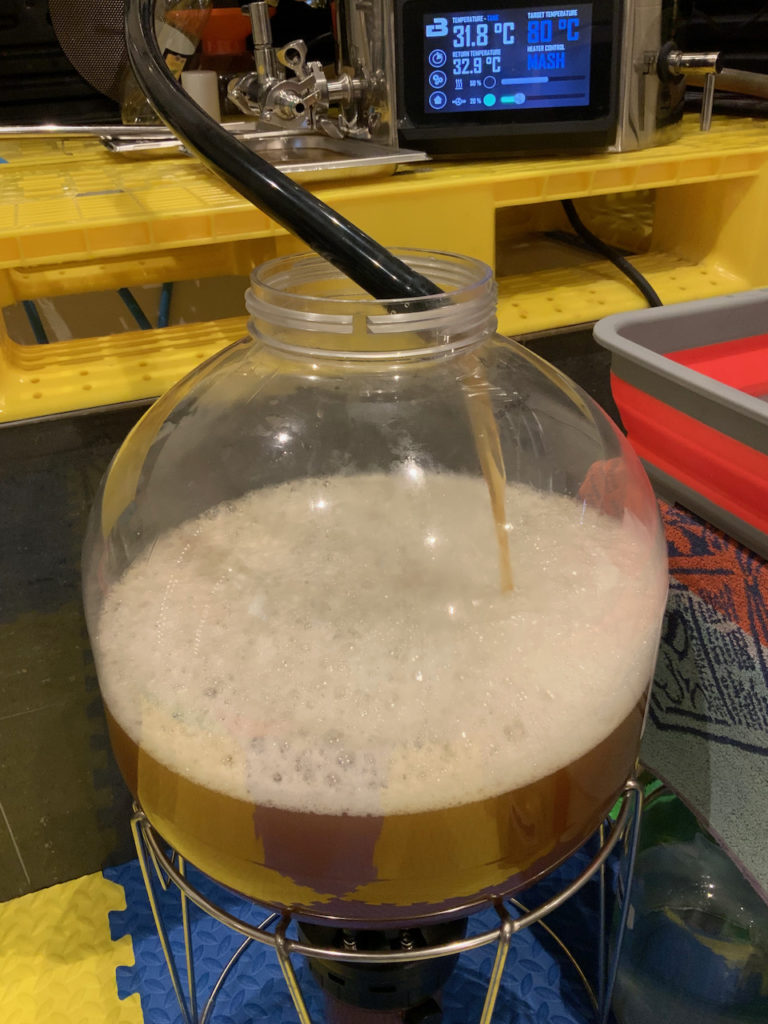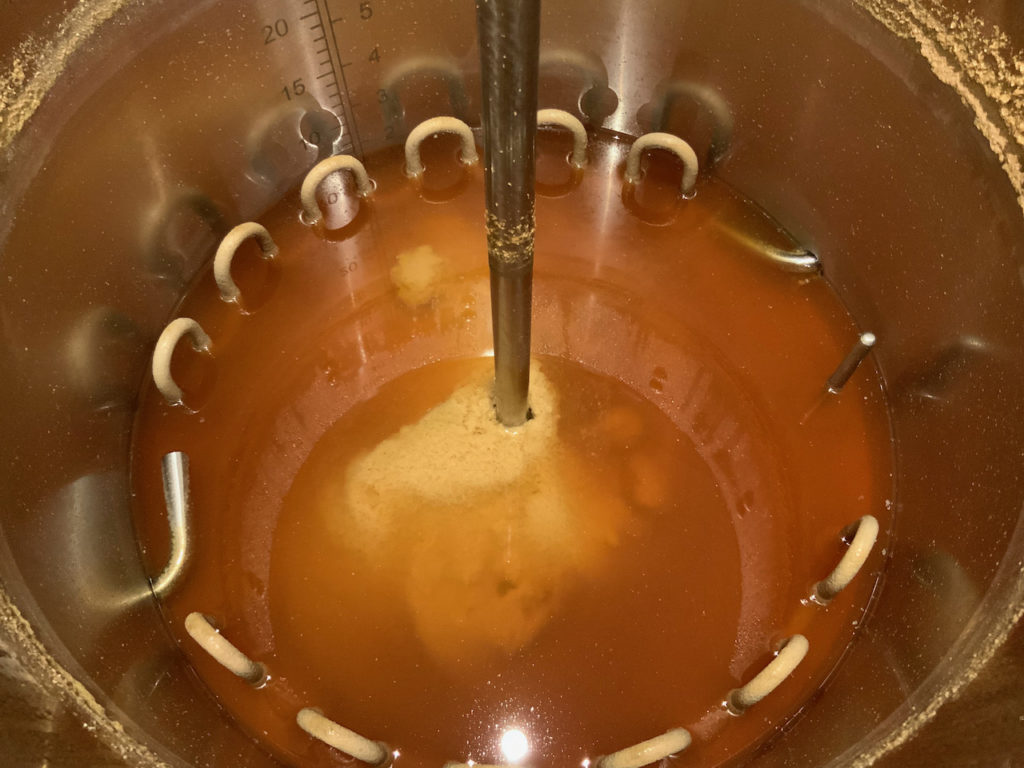Another day, another brew. This time I’m using up some odds ‘n’ sods in my inventory without really aiming for anything specific, other than a light-ish ale of 5% ABV or less.
Also being used up is a tiny amount of Opshaug Kveik that was scavenged from a previous brew and has been sitting in my fridge for an indeterminate number of weeks. I made a starter from this but it hadn’t really taken off by the time I wanted to pitch, so I left the wort in my fermentation fridge for a few hours until I decided whether to chuck in the starter as-is or pitch some dry yeast instead. In the end I threw in the Kveik and I’m glad I did, because by next morning it had gone ballistic!
Sparge Success
Back to the brew day itself, and everything went pretty much according to plan. I used the new sparge attachment from Brewtools during the sparge stage and it worked flawlessly, giving a nice even spread with just the right amount of flow. The only difficulty was getting the mash hat off the centre pipe in order to fit the sparge tool, a process that took a lot of wiggling. Maybe some more silicone grease will help next time. At any rate I don’t think I can use the sparge tool for mashing as well, the holes are very small and likely to block up and those six arms will probably get in the way of my mash paddle.

Learning Opportunity
For the past couple of brews I’ve been filling my entire system with mash water on the evening before brew day, including the chiller coil and link pipe, then reading the levels off the internal scale with the malt pipe fitted. I’m now wondering if that’s the right thing to do. Yes, there will be slightly less chiller loss if the chiller is full of water rather than air, but that water will dilute the wort (and therefore skew boil efficiency) as the chiller is cut in 15 minutes from the end of the boil. Maybe I should leave the chiller and link pipe dry when adding mash water and just accept a higher loss in that respect than trying to fudge things by adding water to the chiller and plumbing, which isn’t going to be represented by the internal scale since that has no idea what’s connected to the kettle. Need to look at the numbers and revisit this.
Raw Brew Day Notes
08:30 – Heaters on 100%, water at 19℃, target 68℃.
08:57 – Heaters to mash mode, starting dough-in
09:03 – Dough-in complete, starting 20 minute timer for the mash rest.
09:23 – Mash rest complete, time for first stir and to start circulating through the centre pipe. First a quick look at levels: around 26 litres. Brewfather predicted 25 litres.
10:04 – Just under half an hour left to run on this mash, and it’s been a bit sticky here and there, requiring constant adjustment of the flow balance and some stirring. I’ve thought about fitting my new sparge attachment which is supposedly also suitable for mashing, but I have a feeling that the holes will get blocked up quickly and that it’ll be in the way of my mash paddle when stirring. Can’t wait to try it out during the sparge though.
10:34 – Mash complete, raising temperature to 71℃ for a mini mash-out while waiting for the levels to settle. Post-mash gravity 1.059 (1.042 @ 62.8℃). Looks like about 24 litres in the kettle prior to sparge.
10:44 – Starting sparge with new hat fitted … HLT temp 73℃. Really nice level of control, good water distribution. HLT ball valve open all the way, pumps at 20%, occasional pause as water builds up on top of mash.
10:52 – Sparge complete, letting her drip for a while with heaters now at 100% approaching boil.
11:00 – Malt pipe removed, pre-boil volume 26.5 litres (BF: 28.86) pre-boil gravity 1.049 (1.027 @ 70.8℃, BF: 1.043). Looks like I’ve lost a tad more liquid during mashing and bumped up the gravity instead. Let’s see how that looks after boil.
11:23 – Added 1/4 tsp Lipohop while stirring the hot break in, keen to see if it makes any difference as it has when I use it for the starter. Temp 98℃.
11:26 – Boil tracker started, added 11.7g Chinook, reduce heater to 60-65%, steam hat on.
12:08 – 15 minute boil additions in, getting ready to include the chiller coil for sanitation.
12:28 – Boil complete, chilling to 80℃ for hop-stand and final additions. Steam hat removed.
12:32 – Starting 20 minute hop stand, added 20g Chinook. Post-boil kettle volume is 24.5 litres (BF: 26.46) post-boil gravity 1.049 (1.028 @ 68.4℃, BF: 1.047). I’m guessing that the water in the chiller has absorbed some of the gravity points gained as a result of mash losses, so next time I may leave the chiller empty when filling the mash water.
12:57 – Starting to chill ahead of FV transfer.
13:38 – Transfer finished, but the starter’s not ready yet. I’ll put this in the fermentation fridge at 23℃ for a couple of hours while I decide whether to pitch the starter anyway or throw in a couple of packets of dry yeast instead. Deploying blue tilt while I’m here. Looks like around 19 litres only in the FV, which is a shame. Ton of trub in the kettle though.
15:00 – Clean-up finished.
21:00 – Pitched yeast starter at 23℃
Recipe
Malts (4.65 kg)
- 1.25 kg (26.9%) — Crisp Clear Choice Malt ® Ale — Grain — 5 EBC
- 1 kg (21.5%) — Thomas Fawcett Pale Malt, Golden Promise — Grain — 5 EBC
- 1 kg (21.5%) — BestMalz Pilsen Malt — Grain — 3.5 EBC
- 500 g (10.8%) — Crisp Extra Pale Maris Otter® Malt — Grain — 3 EBC
- 500 g (10.8%) — Simpsons Rye Malted — Grain — 4 EBC
- 400 g (8.6%) — Simpsons Caramalt — Grain — 36 EBC
Hops (51.7 g)
- 11.7 g (15 IBU) — Chinook 11.8% — Boil — 60 min
- 20 g (14 IBU) — Chinook 11.8% — Boil — 15 min
- 20 g (4 IBU) — Chinook 11.8% — Aroma — 20 min hopstand


